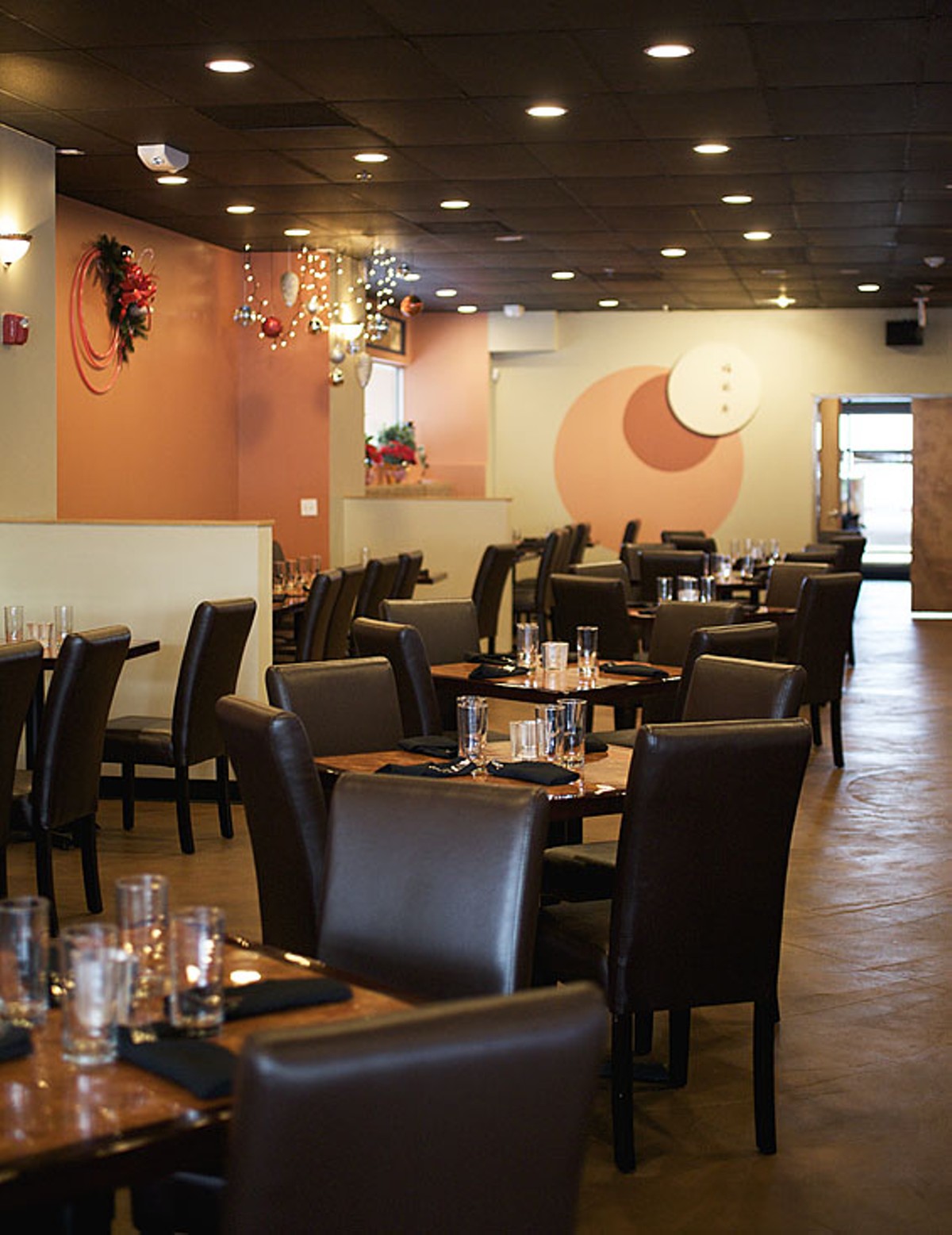Ginger Bistro describes its cuisine as "pioneering Asian fusion." It might be the first Asian fusion restaurant located inside an old Blockbuster video store, which I suppose would make it a pioneer of retail development. Its food, however, isn't what we mean by Asian fusion. Yes, you can find wasabi mashed potatoes on the menu, along with a few of the other ideas that helped turn the concept of "fusion cuisine" from an intriguing intermingling of ingredients and techniques into a cliché or a punch line (or both). For the most part, though, the menu reads like a roll call of America's most loved Asian (and "Asian") dishes: kung pao chicken, California rolls, pad Thai. There are even a couple of nods to current trends, such as banh mi.
Except that this banh mi has honey ham on it.
Ginger Bistro opened in late September of last year in the Delmar Loop, and as soon as you step inside the restaurant for the first time, you can understand why the kitchen has dumbed down its banh mi sandwich with American-style cold cuts for a broader appeal: The place is enormous, seating well over 100. (With its dim lighting and subdued décor, "cavernous" might be a better description.)
The banh mi was fusion cuisine before it had a name, a hybrid of Vietnamese and French traditions: meat (often a combination of ham, headcheese and pâté) and several different vegetables, most notably chiles, cilantro and pickled daikon, inside a crusty baguette. At Ginger Bistro you can choose either the aforementioned honey ham or beef bulgogi, a Korean dish. Teeth gritted, I opted for the honey ham. It was in the ballpark — or at least, in the neighborhood in the vicinity of the ballpark — of an authentic banh mi.
The menu did mention pâté, but there was none on my sandwich. There wasn't that much honey ham, either: a few tissue-thin slices, pale and watery and wrinkled. Worse than the meat was the baguette: It wasn't at all crusty and had the dull chew and insipid flavor of grocery-store white bread. Its blandness smothered whatever pop the vegetables might have provided.
A pall of white-bread blandness settled over almost everything I tried at Ginger Bistro — so pervasive was this pall that when a order of the "Hot and Spicy Calamari" turned out to be inedibly salty, it provided a moment of relief: The calamari were awful, but at least I knew my taste buds still worked. Contrast this with another appetizer, "Korean Hot Chicken Wings." The menu promises wings in "hot, spicy Korean sauce." Leaving aside that "Korean sauce" sounds like it is made from actual Koreans, those who love pungent gochujang paste or belong to the cult that worships fiery Korean-style fried chicken will be forgiven for licking their chops. Yet what arrive are tiny wings, battered and then fried, with a strong whiff of up-from-frozen about them. The "Korean" sauce is served on the side, barely hot, barely piquant, barely worth mentioning.
"BBQ Pork Bamboo Pot," one of the "House Special" entrées, combines shockingly flavorless slices of (allegedly) Cantonese-style barbecued pork with vegetables — which vegetables don't matter, you can't taste 'em — over rice. This is topped with a beaten and runny egg. This looks like snot, but it does give the dish a touch of sweetness. "Spicy Coconut Curry Chicken," another of the house specialties, tastes like a Thai yellow curry if you left out the curry paste and cut the coconut milk with water.
"Sweet and Hot Pepper Chicken" achieves a trifecta, being neither sweet nor hot nor peppery. Instead the dish, which besides chicken contains mushrooms, zucchini and red and green bell peppers, has an unpleasant flavor reminiscent of burnt soy sauce. Kung pao beef is passable, with some actual kick — ask for it extra hot — but undercut by the main ingredient, the texture of which I found discomfitingly soft.
On my final visit, I tried yet another house specialty, the bulgogi. It wasn't the worst dish I ate at Ginger Bistro, yet it crystallized what bothers me about the place. First, the good: The beef's texture was, well, beef-like, tender but with some chew; its flavor suggested garlic, sesame oil and soy sauce. Yet if I didn't know that this was a grilled preparation, I'd never have guessed it. The meat had no flavor of char, no sizzle of ambient heat. The presentation couldn't have been less inspired: one pile of beef strips, two scoops of white rice, a pile of limp vegetables.
It goes without saying that, unlike bulgogi (or any entrée) at a traditional Korean restaurant, there were no ban chan, the half-dozen (or more) hot and cold side dishes that accompany the main course. That might not be a fair complaint — after all, Ginger Bistro doesn't claim to be a traditional Korean restaurant. To which I reply, "True," and, "So what?"
A decade ago, maybe, you would celebrate a restaurant introducing a mass audience to banh mi or beef bulgogi, however debased that restaurant's specific examples might be. In 2011, thanks to the explosion of food-related books, TV shows and blogs, we expect more of our restaurants. We expect them to respect our growing knowledge about food. We expect them to reward our curiosity to learn even more. We expect them to understand that if they try to pass off a banh mi with honey ham in it as a cultural lesson, we are going to take to Yelp or Urbanspoon or this here column to call them out for it.
Ginger Bistro might not be an Asian fusion restaurant, but it has one very important thing in common with that cuisine: It is a relic.






